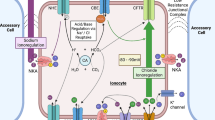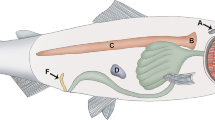Abstract
Antimicrobial peptides (AMPs) are important mediators of the immune response against bacteria and cysteine-rich peptide hepcidin is a 20–26 residues member with functions in iron regulation and antimicrobial activity. Here, we have identified two different types of hepcidin cDNA from the Black rockfish, Sebastes schlegelii, by EST analysis. Both hepcidin genes (hepcidin I and II) consist of two introns and three exons that encode a prepropeptide (88 amino acids). A TATA box and several consensus-binding motifs for transcription factors were found in the upstream of the transcriptional start site. Semi-quantitative RT-PCR analysis suggested that hepcidin I transcripts were detected in various tissues, while hepcidin II was only expressed in the liver. During the bacterial challenge with the fish pathogen, Streptococcus iniae, two hepcidin genes were differentially expressed. Hepcidin I and II dramatically increased at 24 h post-injection, then gradually declined at 3 days in hepcidin II, while hepcidin I expression continued at 3 days after challenge.





Similar content being viewed by others
References
Andreu D, Rivas L (1998) Animal antimicrobial peptides: an overview. Biopolymers 46:415–433
Lehrer RI, Ganz T (1999) Antimicrobial peptides in mammalian and insect host defence. Curr Opin Immunol 11:23–27. doi:10.1016/S0952-7915(99)80005-3
Hancock REW, Lehrer R (1998) Cationic peptides: a new source of antibiotics. Trends Biotechnol 16:82–88. doi:10.1016/S0167-7799(97)01156-6
Chen SL, Xu MY, Ji XS, Yu GC, Liu Y (2005) Cloning, characterization and expression analysis of hepcidin gene from red sea bream (Chrysophrys major). Antimicrob Agents Chemother 49:1608–1612
Shike H, lauth X, Westerman ME, Ostland VE, Carlberg JM, Van Olst JC, Shimizu C, Bulet P, Burns JC (2002) Bass hepcidin is a novel antimicrobial peptide induced by bacterial challenge. Eur J Biochem 269:2232–2237. doi:10.1046/j.1432-1033.2002.02881.x
Cuesta A, Meseguer J, Esteban MA (2007) The antimicrobial peptide hepcidin exerts as important role in the innate immunity against bacteria in the bony fish gilthead seabream. Mol Immunol 45:2333–2342. doi:10.1016/j.molimm.2007.11.007
Douglas SE, Gallant JW, Ryan SL, Andrew D, Stephen CMT (2003) Identification and expression analysis of hepcidin-like antimicrobial peptides in bony fish. Dev Comp Immunol 27:589–601. doi:10.1016/S0145-305X(03)00036-3
Kim YO, Hong SH, Nam BH, Lee JO, Kim KK, Lee SJ (2005) Molecular cloning and expression analysis of two hepcidin genes from olive flounder Paralichthys olivaceus. Biosci Biotechnol Biochem 69:1411–1414. doi:10.1271/bbb.69.1411
Hirono I, Hwang JY, Ono Y, Kurobe T, Ohira T, Nozaki R et al (2005) Two different types of hepcidins from Japanese flounder Paralichthys olivaceus. FEBS J 272:5257–5264. doi:10.1111/j.1742-4658.2005.04922.x
Bao B, Peatman E, Li P, He C, Liu Z (2005) Catfish hepcidin gene is expressed in a wide range of tissues and exhibits tissue-specific up-regulation after bacterial infection. Dev Comp Immunol 29:939–950. doi:10.1016/j.dci.2005.03.006
Chen SL, Li W, Meng L, Sha ZX, Wang ZJ, Ren GC (2007) Molecular cloning and expression analysis of a hepcidin antimicrobial peptide gene from turbot (Scophthalmus maximus). Fish Shellfish Immunol 22:172–181. doi:10.1016/j.fsi.2006.04.004
Shike H, Shimizu C, Lauth X, Burns JC (2004) Organization and expression analysis of the zebrafish hepcidin gene, an antimicrobial peptide gene conserved among vertebrates. Dev Comp Immunol 28:747–754. doi:10.1016/j.dci.2003.11.009
Lauth X, Babon JJ, Stannards JA, Singh S, Nizet V, Carlberg JM (2005) Bass hepcidin synthesis, solution structure, antimicrobial activities and synergism, and in vivo hepatic response to bacterial infections. J Biol Chem 280:9272–9282. doi:10.1074/jbc.M411154200
Ganz T (2004) Hepcidin in iron metabolism. Curr Opin Hematol 11:251–254. doi:10.1097/00062752-200407000-00004
Nicolas G, Bennoun M, Devaux I, Beaumont C, Grandchamp B, Kahn A et al (2001) Lack of hepcidin gene expression and severe tissue iron overload in upstream stimulatory factor 2 (USF2) knockout mice. Proc Natl Acad Sci USA 98:8780–8785. doi:10.1073/pnas.151179498
Weinstein DA, Roy CN, Fleming MD, Loda MF, Wolfsdorf JI, Andrews NC (2002) In appropriate expression of hepcidin is associated with iron refractory anemia: complications for the anemia of chronic disease. Blood 100:3776–3781. doi:10.1182/blood-2002-04-1260
Ilyin G, Courselaud B, Troadec M-B, Pigeon C, Alizadeh M, Lerover P et al (2003) Comparative analysis of mouse hepcidin 1 and 2 genes: evidence for different patterns of expression and co-inducibility during iron overload. FEBS Lett 542:22–26. doi:10.1016/S0014-5793(03)00329-6
Pigeon C, Ilyin G, Courselaud B, Leroyer P, Turlin B, Brissot P et al (2001) A new mouse liver-specific gene, encoding a protein homologous to human antimicribial peptide hepcidin, is overexpressed during iron overload. J Biol Chem 276:7811–7819. doi:10.1074/jbc.M008923200
Lee P, Peng H, Gelbart T, Beutler E (2004) The IL-6-and lipopolysaccharide-induced transcription of hepcidin in HFE-, transferrin receptor 2-, and β2-microglobulin-deficient hepatocytes. Proc Natl Acad Sci USA 101:9263–9365. doi:10.1073/pnas.0403108101
Thompson JD, Higgins DG, Gibson TJ (1994) CLUSTAL W: improving the sensitivity of progressive multiple sequence alignment through sequence weighting, position specific gap penalties and weight matrix choice. Nucleic Acids Res 22:4673–4680. doi:10.1093/nar/22.22.4673
Saitou N, Nei M (1987) The neighbor-joining method: a new method for reconstructing phylogenetic trees. Mol Biol Evol 4(4):406–425
Takashi A, Takanori K, Kenji S, Ichiro N (1996) Tissue preservation and total DNA extraction from fish stored at ambient temperature using buffers containing high concentration of urea. Fish Sci 62(5):727–730
Nakayama K (1997) Furin: a mammalian subtilisin/Kex2p-like endoprotease involved in processing of a wide variety of precursor proteins. Biochem J 327:625–635
Park CH, Valore EV, Waring AJ, Ganz T (2001) Hepcidin, a urinary antimicrobial peptide synthesized in the liver. J Biol Chem 276:7806–7810. doi:10.1074/jbc.M008922200
Lekstrom-Himes J, Xanthopoulos KG (1998) Biological role of the CCAAT/enhancer-binding family of transcription factors. J Biochem 273:28545–28548
Anderson KV (2000) Toll signaling pathways in the innate immune response. Curr Opin Immunol 12:13–19. doi:10.1016/S0952-7915(99)00045-X
Author information
Authors and Affiliations
Corresponding author
Rights and permissions
About this article
Cite this article
Kim, YO., Park, EM., Nam, BH. et al. Identification and molecular characterization of two hepcidin genes from black rockfish (Sebastes schlegelii). Mol Cell Biochem 315, 131–136 (2008). https://doi.org/10.1007/s11010-008-9796-3
Received:
Accepted:
Published:
Issue Date:
DOI: https://doi.org/10.1007/s11010-008-9796-3




